Elliott Wave Scrapbook




Impulses can be Extensions or Truncations


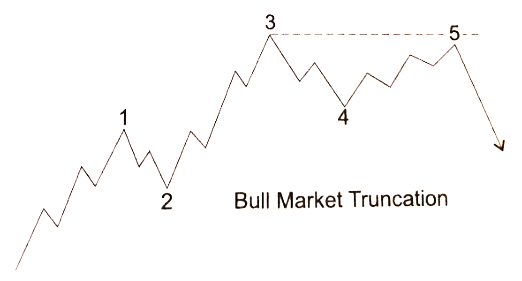
IMPULSE RULES
- An impulse always subdivides into five waves.
- Wave 1 always subdivides into an impulse or (rarely) a diagonal.
- Wave 3 always subdivides into an impulse.
- Wave 5 always subdivides into an impulse or diagonal.
- Wave 2 always subdivides into a zigzag, flat or combination.
- Wave 4 always subdivides into a zigzag, flat, triangle or combination.
- Wave 2 never moves beyond the start of wave 1.
- Wave 3 always moves beyond the end of wave 1.
- Wave 3 is never the shortest wave.
- Wave 4 never moves beyond the end of wave 1.
- Never are waves 1, 3 and 5 all extended.
IMPULSE GUIDELINES
- Wave 4 will almost always be a different corrective pattern to that of wave 2.
- Wave 2 is usually a zigzag or zigzag combination.
- Wave 4 is usually a flat, triangle or flat combination.
- Sometimes wave 5 does not move beyond the end of wave 3 (in which case it's called a truncation).
- Wave 5 often ends when meeting or slightly exceeding a line drawn from the end of wave 3 that is parallel to the line connecting the ends of waves 2 and 4, on either arithmetic or semilog scale.
- The center of wave 3 almost always has the steepest slope of any equal period within the parent impulse except that sometimes an early portion of wave 1 (the “kickoff”) will be steeper.
- Wave 1, 3 or 5 is usually extended. (An extension appears “stretched” because its corrective waves are small compared to its impulse waves. It is substantially longer, and contains larger subdivisions, than the non-extended waves).
- Often, the extended subwave is the same number (1, 3 or 5) as the parent wave.
- Rarely do two subwaves extend, although it is typical for waves 3 and 5 both to extend when they are of Cycle or Supercycle degree and within a fifth wave of one degree higher.
- Wave 1 is the least commonly extended wave.
- When wave 3 is extended, waves 1 and 5 tend to have gains related by equality or the Fibonacci ratio.
- When wave 5 is extended, it is often in Fibonacci proportion to the net travel of waves 1 through 3.
- When wave 1 is extended, it is often in Fibonacci proportion to the net travel of waves 3 through 5.
- Wave 4 typically ends when it is within the price range of subwave four of 3.
- Wave 4 often subdivides the entire impulse into Fibonacci proportion in time and/or price.
Diagonals can be Leading (Wave 1), Ending (Wave 5) and both can also be Expanded
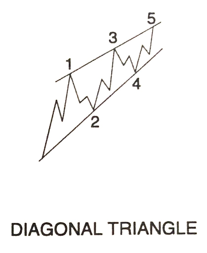

DIAGONAL RULES
- A diagonal always subdivides into five waves.
- An ending diagonal always appears as wave 5 of an impulse or wave C of a zigzag or flat.
- A leading diagonal always appears as wave 1 of an impulse or wave A of a zigzag.
- Waves 1, 2, 3, 4 and 5 of an ending diagonal, and waves 2 and 4 of a leading diagonal, always subdivides into zigzags.
- Wave 2 never goes beyond the start of wave 1.
- Wave 3 always goes beyond the start of wave 1.
- Wave 4 never moves beyond the end of wave 2.
- Wave 4 always ends within the price territory of wave 1.
- Going forward in time, a line connecting the ends of wave 2 and 4 converges towards (in the contracting variety) or diverges from (in the expanding variety) a line connecting the ends of waves 1 and 3.
- In a leading diagonal, wave 5 always ends beyond the end of wave 3.
- In the contracting variety, wave 3 is always shorter than wave 1, wave 4 is always shorter than wave 2, and wave 5 is always shorter than wave 3.
- In the expanding variety, wave 3 is always longer than wave 1, wave 4 is always longer than wave 2, and wave 5 is always longer than wave 3.
- In the expanding variety, wave 5 always ends beyond the end of wave 3.
DIAGONAL GUIDELINES
- Wave 4 usually ends within the price territory of wave 1.
- Waves 2 and 4 each usually retrace .66 to .81 of the preceding wave.
- Waves 1, 3 and 5 of a leading diagonal usually subdivide into zigzags but sometimes appear to be impulses.
- Within an impulse, if wave 1 is a diagonal, wave 3 is likely to be extended.
- Within an impulse, wave 5 is unlikely to be a diagonal if wave 3 is not extended.
- In the contracting variety, wave 3 is usually shorter than wave 1.
- In the expanding variety, wave 3 is usually longer than wave 1.
- In the contracting variety, wave 5 usually ends beyond the end of wave 3. (Failure to do so is called a truncation.)
- In the contracting variety, wave 5 usually ends at or slightly beyond a line that connects the ends of waves 1 and 3. (Ending beyond that line is called a throw-over.)
- In the expanding variety, wave 5 usually ends slightly before reaching a line that connects the ends of waves 1 and 3.
Zigzags can be Single, Double (W-X-Y) or Tripple (W-X-Y-X-Z)

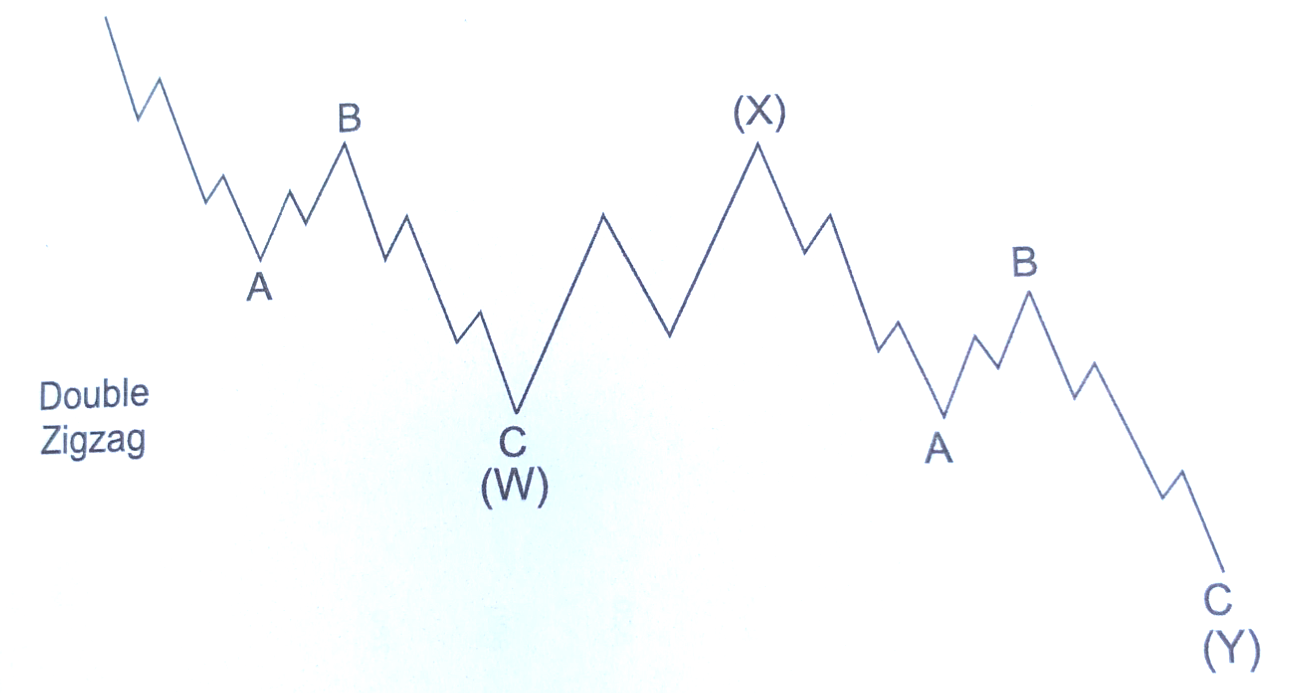
ZIGZAG RULES
- A zigzag always subdivides into three waves.
- Wave A always subdivides into an impulse or leading diagonal.
- Wave C always subdivides into an impulse or diagonal.
- Wave B always subdivides into a zigzag, flat, triangle or combination thereof.
- Wave B never moves beyond the start of wave A.
ZIGZAG GUIDELINES
- Wave A almost always subdivides into an impulse.
- Wave C almost always subdivides into an impulse.
- Wave C is often about the same length as wave A.
- Wave C almost always ends beyond the end of wave A.
- Wave B typically retraces 38 to 79 percent of wave A.
- If wave B is a running triangle, it will typically retrace between 10 and 40 percent of wave A.
- If wave B is a zigzag, it will typically retrace 50 to 79 percent of wave A.
- If wave B is a triangle, it will typically retrace 38 to 50 percent of wave A.
- A line connecting the ends of waves A and C is often parallel to a line connecting the end of wave B and the start of wave A. (Forecasting guideline: Wave C often ends upon reaching a line drawn from the end of wave A that is parallel to a line connecting the start of wave A and the end of wave B.)
Flats can be Regular, Expanded or Running

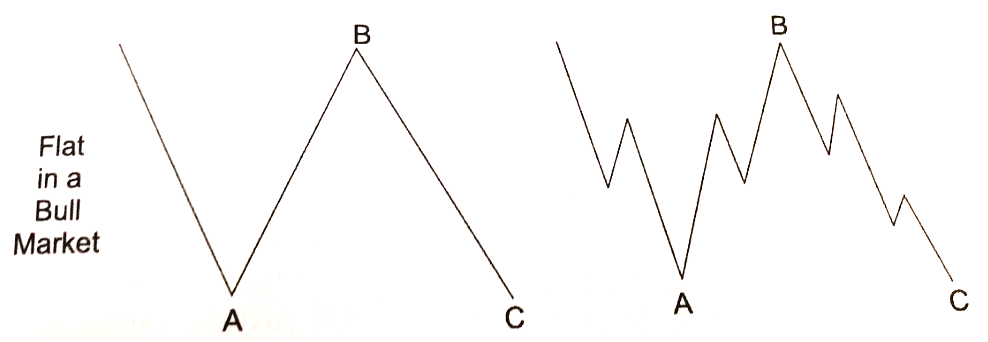

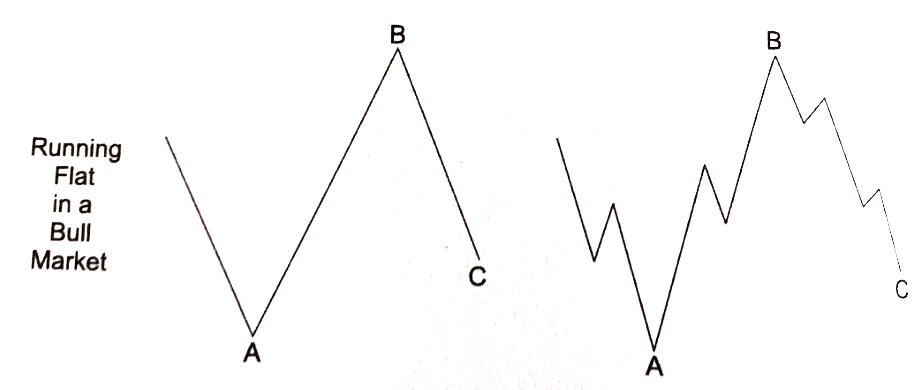
FLAT RULES
- A flat always subdivides into three waves.
- Wave A is never a triangle.
- Wave C is always an impulse or diagonal.
- Wave B always retraces at least 90 percent of wave A.
FLAT GUIDELINES
- Wave B usually retraces between 100 and 138 percent of wave A.
- Wave C is usually between 100 and 165 percent as long as wave A.
- Wave C usually ends beyond the end of wave A.
FLAT NOTES
- When wave B is more than 105 percent as long as wave A and wave C ends beyond the end of wave A, the entire formation is called an expanded flat.
- When wave B is more than 100 percent as long as wave A and wave C does not end beyond the end of wave A, the entire formation is called a running flat.
Triagles can be Contracting, Barrier, Expanding or Running but are always Wave 4 or Wave B


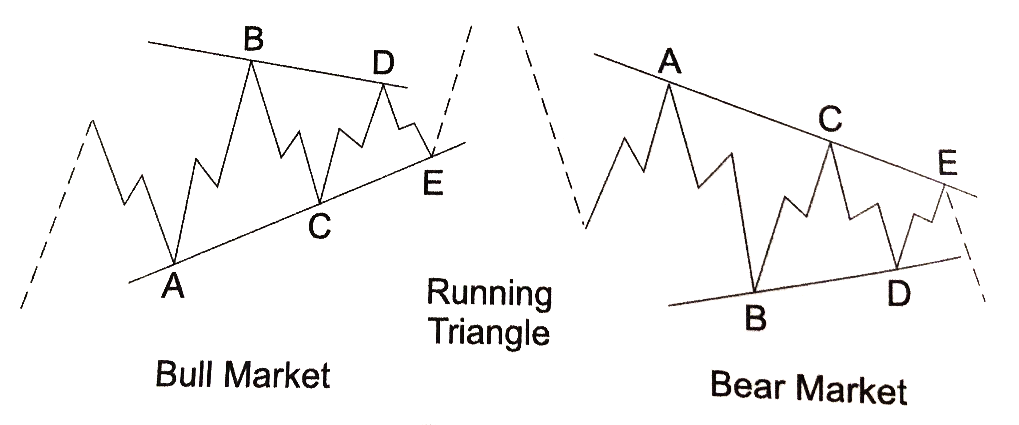
CONTRACTING TRIANGLE RULES
- A triangle always subdivides into five waves.
- At least four waves among waves A, B, C, D and E each subdivide into a zigzag or zigzag combination.
- Wave C never moves beyond the end of wave A, wave D never moves beyond the end of wave B, and wave E never moves beyond the end of wave C. The result is that going forward in time, a line connecting the ends of waves B and D converges with a line connecting the ends of waves A and C.
- A triangle never has more than one complex subwave, in which case it is always a zigzag combination or a triangle.
CONTRACTING TRIANGLE GUIDELINES
- Usually, wave C subdivides into a zigzag combination that is longer lasting and contains deeper percentage retracements than each of the other subwaves.
- Sometimes, wave D subdivides into a zigzag combination that is longer lasting and contains deeper percentage retracements than each of the other subwaves.
- Sometimes one of the waves, usually wave C, D or E, subdivides into a contracting or barrier triangle. Often the effect is as if the entire triangle consisted of nine zigzags.
- About 60 percent of the time, wave B does not end beyond the start of wave A. When it does, the triangle is called a running triangle.
BARRIER TRIANGLE RULES & GUIDELINES
A barrier triangle has the same characteristics as a contracting triangle except:
- Waves B and D end at essentially the same level. We have yet to observe a 9-wave barrier triangle, implying that this form may not extend.
- When wave 5 follows a triangle, it is typically either a brief, rapid movement or an exceptionally long extension.
EXPANDING TRIANGLE RULES
Most rules are the same as for contracting triangles, with these differences:
- Wave C, D and E each moves beyond the end of the preceding same-directional subwave. The result is that going forward in time, a line connecting the ends of waves B and D diverges from a line connecting waves A and C.
- Subwaves B, C and D each retrace at least 100 percent but no more than 150 percent of the preceding subwave.
EXPANDING TRIANGLE GUIDELINES
Most guidelines are the same as for contracting triangles, with these differences:
- Subwaves B, C and D usually retrace 105 to 125 percent of the preceding subwave.
- No subwave has yet been observed to subdivide into a triangle.
Combinations can be Double Three or Tripple Three
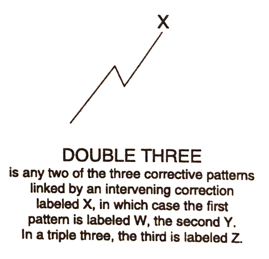

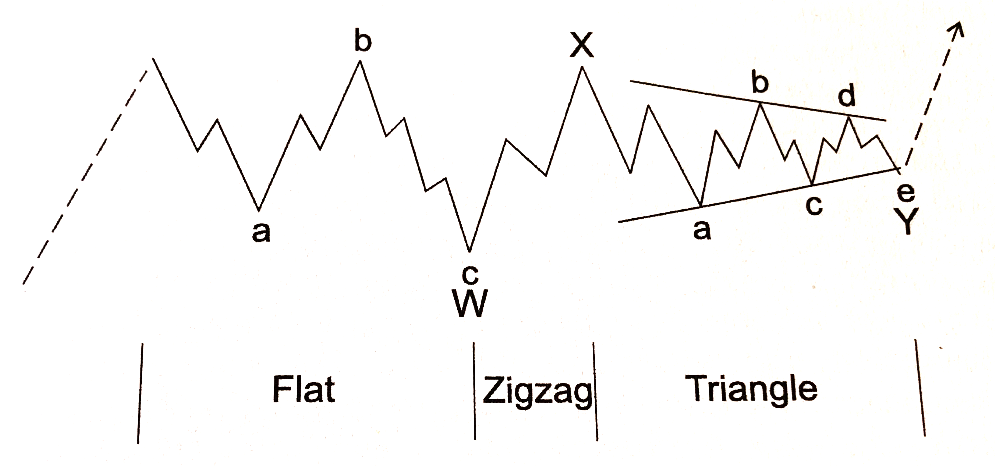
COMBINATION RULES
- Combinations comprise two (or three) corrective patterns separated by one (or two) corrective pattern(s) in the opposite direction, labeled X. The first corrective pattern is labeled W, with the second Y, and the third, if there is one, Z.
- A zigzag combination comprises two or three zigzags (in which case it is called a double or triple zigzag).
- A "double three" flat combination comprises (in order) a zigzag and a flat, a flat and a zigzag, a flat and a flat, a zigzag and a triangle or a flat and a triangle.
- A rare "triple three" flat combination comprises three flats.
- Double and triple zigzags take the place of zigzags, and double and triple threes take the place of flats and triangles.
- An expanding triangle has yet to be observed as a component of a combination.
COMBINATION GUIDELINES
- When a zigzag or flat appears too small to be the entire wave with respect to the preceding wave (or, if it is to be wave 4, the preceding wave 2), a combination is likely.